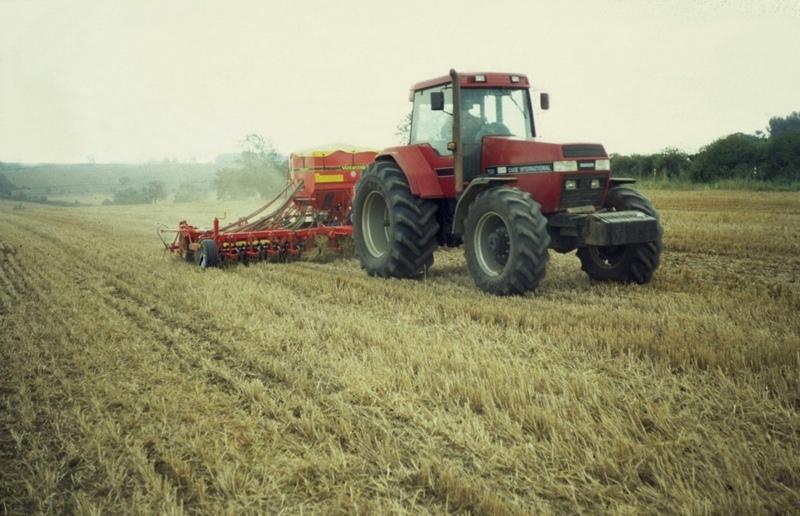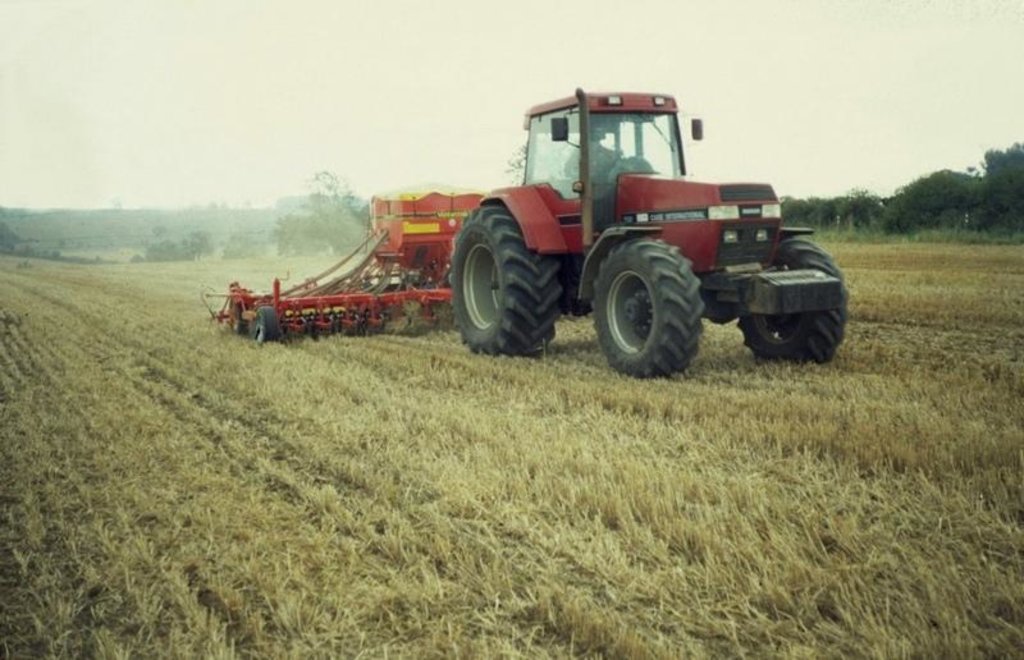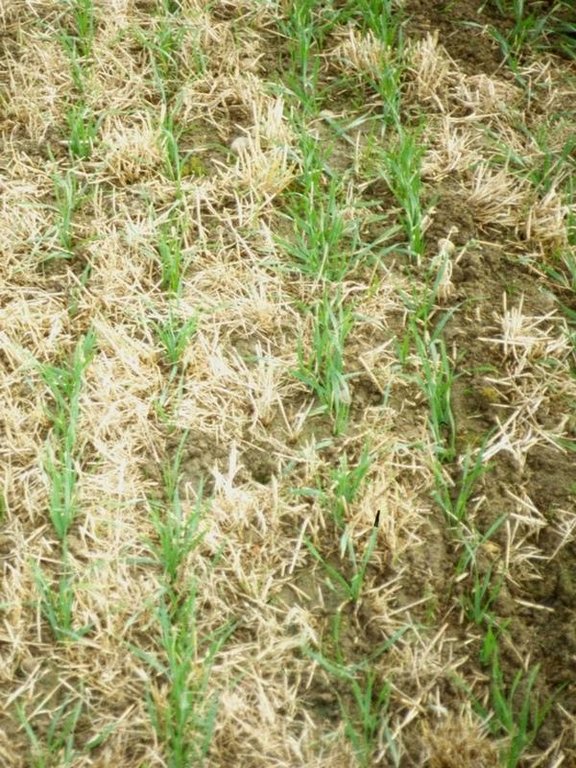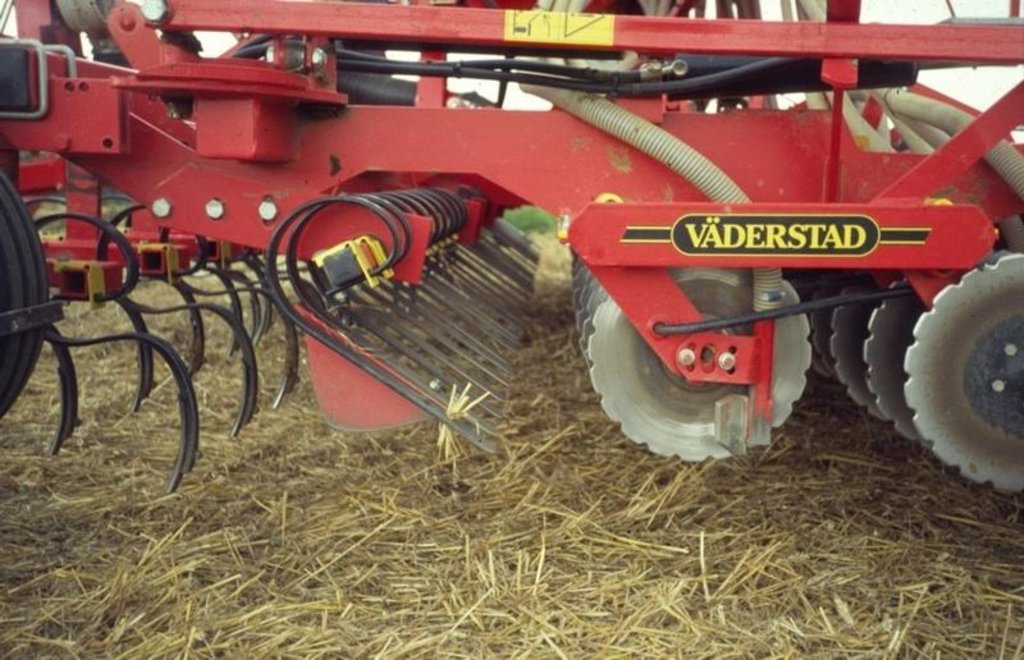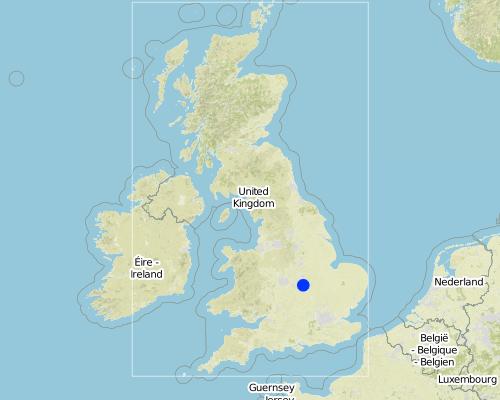Conservation agriculture [Reino Unido]
- Criação:
- Atualização:
- Compilador/a: Alastaire Leake
- Editor: –
- Revisor: Fabian Ottiger
non-inversion tillage, incorporation of crop residues, non-selective herbicides
technologies_987 - Reino Unido
Veja as seções
Expandir tudo Recolher tudo1. Informação geral
1.2 Detalhes do contato das pessoas capacitadas e instituições envolvidas na avaliação e documentação da tecnologia
Nome do projeto que facilitou a documentação/avaliação da Tecnologia (se relevante)
Soil and water protection (EU-SOWAP)Nome da(s) instituição(ões) que facilitou(ram) a documentação/ avaliação da Tecnologia (se relevante)
Game & Wildlife Conservation Trust - Reino Unido1.3 Condições em relação ao uso da informação documentada através de WOCAT
Quando os dados foram compilados (no campo)?
01/10/2004
O/a compilador/a e a(s) pessoa(s) capacitada(s) aceitam as condições relativas ao uso de dados documentados através da WOCAT:
Sim
2. Descrição da tecnologia de GST
2.1 Descrição curta da tecnologia
Definição da tecnologia:
Improved soil management based on non-inversion tillage for cost-effective and timely crop establishment.
2.2 Descrição detalhada da tecnologia
Descrição:
Conservation agriculture (CA), involving superficial non-inversion tillage, began to be widely taken up in England following advances in seed drill technology, non-selective herbicides and straw-chopping combine harvesters in the late 1980s.
This case focuses on the Game Conservancy Trust’s Allerton Project at Loddington, which in 2000 pooled resources with its neighbour to purchase a single set of cultivation equipment, and replaced conventional mouldboard ploughing (with its multiple cultivations) by state-of-the-art CA. Contract services offered by the joint venture means that 1,000 ha are now covered each year. The main winter crops are wheat, oats, and oilseed rape. Beans are sown in the spring. The heavy clay loam is vulnerable to excessive surface moisture, restricting crop establishment
‘windows’.
Immediately after harvest the soil is loosened and straw incorporated, and then soil is consolidated (using a ‘cultivation train’ combining two machines: the ‘Simba Solo’ and the ‘Cultipress’). This encourages up to 60% of the weeds to emerge in a ‘stale seedbed’. Spraying then removes all the weeds and volunteer plants of previous crops. This is followed by a light surface tillage, using the ‘Väderstad Rapid Cultivator Drill’, before sowing into the seedbed created. Equipment comprises implements with tines and/or discs which create a tilth to around 10 cm
without inverting the soil. Cambridge rollers are then used to consolidate the sown land. After crop maturity, combine harvesting takes place - with simultaneous chopping of straw/crop residues. A trash rake is used to disperse the chopped straw. This way excessive trash is incorporated rapidly into the soil. Compaction may arise in the transition phase, because of the lack of soil loosening through ploughing: minimising traffic, keeping to tramlines and headlands can all help. In time, increases in soil organic matter content and earthworm biomass make compaction less of a problem. The problem of slugs can be reduced by improving seed-to-soil contact, and by drilling deeper.
Purpose of the Technology: The main purpose of conservation agriculture is cost effective, timely and rapid crop establishment, under good soil conditions. High-speed operations are the key. Compared with conventional ploughing, labour is saved and fuel costs lowered. However, an additional application of herbicides represents an extra expenditure. Yields per hectare haven’t risen but the key difference is that about four times as many hectares can be prepared in time for autumn planting under conservation tillage, thus improving overall production. Incorporation of crop residues improves soil structure and leads to a more friable, less erodible topsoil.
2.3 Fotos da tecnologia
2.5 País/região/locais onde a tecnologia foi aplicada e que estão cobertos nesta avaliação
País:
Reino Unido
Região/Estado/Província:
Leicestershire
Map
×2.7 Introdução da tecnologia
Especifique como a tecnologia foi introduzida:
- através de projetos/intervenções externas
3. Classificação da tecnologia de GST
3.1 Principal/principais finalidade(s) da tecnologia
- Reduz, previne, recupera a degradação do solo
3.2 Tipo(s) atualizado(s) de uso da terra onde a tecnologia foi aplicada

Terra de cultivo
- Cultura anual
Principais plantações (colheitas para venda e consumo próprio):
Major cash crop: Wheat, oats,oilseed rape
Comentários:
Major land use problems (compiler’s opinion): Traditional inversion tillage is slow and costly. By moving to high speed non-inversion conservation tillage farmers can
spread costs over a larger area and maximise the area under winter crops. The speed at which ground can be worked in the autumn is critical: one month earlier planting can mean an extra ton in cereal yield.
3.3 Mais informações sobre o uso da terra
Abastecimento de água para a terra na qual a tecnologia é aplicada:
- Misto de precipitação natural-irrigado
Número de estações de cultivo por ano:
- 1
Especifique:
Longest growing period in days: 330Longest growing period from month to month: Mar - Dec
3.4 Grupo de GST ao qual pertence a tecnologia
- Perturbação mínima ao solo
3.5 Difusão da tecnologia
Comentários:
Total area covered by the SLM Technology is 10 m2.
3.6 Medidas de GST contendo a tecnologia
3.7 Principais tipos de degradação da terra abordados pela tecnologia

Erosão do solo pela água
- Wt: Perda do solo superficial/erosão de superfície
- Wg: Erosão por ravinas/ravinamento

Deteriorização química do solo
- Cn: declínio de fertilidade e teor reduzido de matéria orgânica (não causado pela erosão)
Comentários:
Main type of degradation addressed: Wt: loss of topsoil / surface erosion, Wg: gully erosion / gullying, Cn: fertility decline and reduced organic matter content
3.8 Redução, prevenção ou recuperação da degradação do solo
Especifique o objetivo da tecnologia em relação a degradação da terra:
- Reduzir a degradação do solo
4. Especificações técnicas, implementação de atividades, entradas e custos
4.2 Especificações técnicas/ explicações do desenho técnico
Technical knowledge required for field staff / advisors: high
Technical knowledge required for land users: moderate
Main technical functions: improvement of ground cover, increase in organic matter, increase of infiltration, improvement of soil structure, increase in soil fertility
4.6 Atividades recorrentes/manutenção
| Atividade | Tipo de medida | Periodicidade/frequência | |
|---|---|---|---|
| 1. | Loosen the soil and incorporate the straw using the ‘Simba Solo’; soil consolidation, using the 'Cultipress' | Agronômico | immediately post-harvest / |
| 2. | Spray the stale seedbed to remove all the weeds/volunteer plants of previous crops | Agronômico | mid September |
| 3. | Light surface tillage and sowing into the seedbed; using the 'Väderstad Rapid Cultivator Drill' | Agronômico | usually end September, just after spraying |
| 4. | Consolidation of the sown land | Agronômico | using Cambridge rollers |
| 5. | After crop maturity, combine harvesting - with simultaneous chopping of straw | Agronômico | |
| 6. | Disperse the chopped straw, using a trash rake. | Agronômico |
4.7 Custos e entradas necessárias pata a manutenção/atividades recorrentes (por ano)
| Especifique a entrada | Unidade | Quantidade | Custos por unidade | Custos totais por entrada | % dos custos arcados pelos usuários da terra | |
|---|---|---|---|---|---|---|
| Equipamento | Machine use | ha | 1,0 | 180,0 | 180,0 | 100,0 |
| Custos totais para a manutenção da tecnologia | 180,0 | |||||
4.8 Fatores mais importantes que afetam os custos
Descreva os fatores mais determinantes que afetam os custos:
No establishment costs for purchase of special conservation tillage equipment are included here – though this
investment is considerable. Tractors of sufficient horsepower and a couple of special machines (see above) are needed. The investment in this case was shared by two neighbouring farms, who implemented conservation agriculture on a joint venture basis. The only costs presented in the table above are total recurrent annual costs for tillage operations. This total, US$ 180, compares with US$ 260 for conventional tillage operations. While drilling is not included in the above conventional tillage calculation, subsequent application of additional herbicides represents an extra cost of conservation tillage of about US$ 80/ha. In balance the costs per hectare are broadly similar. Labour inputs however are reduced considerably as a proportion: the Allerton farm with its 260 ha of arable land is operated by a farm manager and just one farm worker.
5. Ambiente natural e humano
5.1 Clima
Precipitação pluviométrica anual
- <250 mm
- 251-500 mm
- 501-750 mm
- 751-1.000 mm
- 1.001-1.500 mm
- 1.501-2.000 mm
- 2.001-3.000 mm
- 3.001-4.000 mm
- > 4.000 mm
Zona agroclimática
- Subúmido
Thermal climate class: temperate
5.2 Topografia
Declividade média:
- Plano (0-2%)
- Suave ondulado (3-5%)
- Ondulado (6-10%)
- Moderadamente ondulado (11-15%)
- Forte ondulado (16-30%)
- Montanhoso (31-60%)
- Escarpado (>60%)
Formas de relevo:
- Planalto/planície
- Cumes
- Encosta de serra
- Encosta de morro
- Sopés
- Fundos de vale
Zona de altitude:
- 0-100 m s.n.m.
- 101-500 m s.n.m.
- 501-1.000 m s.n.m.
- 1.001-1.500 m s.n.m.
- 1.501-2.000 m s.n.m.
- 2.001-2.500 m s.n.m.
- 2.501-3.000 m s.n.m.
- 3.001-4.000 m s.n.m.
- > 4.000 m s.n.m.
5.3 Solos
Profundidade do solo em média:
- Muito raso (0-20 cm)
- Raso (21-50 cm)
- Moderadamente profundo (51-80 cm)
- Profundo (81-120 cm)
- Muito profundo (>120 cm)
Textura do solo (solo superficial):
- Médio (limoso, siltoso)
- Fino/pesado (argila)
Matéria orgânica do solo superficial:
- Baixo (<1%)
Caso disponível anexe a descrição completa do solo ou especifique as informações disponíveis, p. ex. tipo de solo, PH/acidez do solo, nitrogênio, capacidade de troca catiônica, salinidade, etc.
Soil fertility is medium
Soil drainage/infiltration is medium
Soil water storage capacity is medium
5.6 Características dos usuários da terra que utilizam a tecnologia
Orientação de mercado do sistema de produção:
- Comercial/mercado
Indique outras características relevantes dos usuários da terra:
Off-farm income specification: contract work on other farms is an important source of additional revenue for the ‘joint venture’ of the two neighbouring farms
5.7 Média da área de terra própria ou arrendada por usuários da terra que utilizam a tecnologia
- < 0,5 ha
- 0,5-1 ha
- 1-2 ha
- 2-5 ha
- 5-15 ha
- 15-50 ha
- 50-100 ha
- 100-500 ha
- 500-1.000 ha
- 1.000-10.000 ha
- > 10.000 ha
5.8 Propriedade de terra, direitos de uso da terra e de uso da água
Propriedade da terra:
- Empresa
- Indivíduo, intitulado
Direitos do uso da terra:
- Arrendado
- Indivíduo
6. Impactos e declarações finais
6.1 Impactos no local mostrados pela tecnologia
Impactos socioeconômicos
Produção
Produção agrícola
Comentários/especificar:
Reduced yields in the early years (due to initial compaction)
Renda e custos
Rendimento agrícola
Impactos socioculturais
Instituições comunitárias
Instituições nacionais
Conhecimento de GST/ degradação da terra
Atenuação de conflitos
Impactos ecológicos
Ciclo hídrico/escoamento
Escoamento superficial
Drenagem de excesso de água
Solo
Umidade do solo
Cobertura do solo
Perda de solo
Matéria orgânica do solo/carbono abaixo do solo
Outros impactos ecológicos
Carbon sequestration
Loss of nutrients (through leaching)
Biodiversity enhancement
Comentários/especificar:
Above and below ground
Soil structure
Organic matter depletion (in certain sandy soils)
Reliance on herbicides
6.2 Impactos externos mostrados pela tecnologia
Cheias de jusante
Sedimentação a jusante
Poluição de água subterrânea/rio
Sedimentos transportados pelo vento
6.4 Análise do custo-benefício
Como os benefícios se comparam aos custos de implantação (do ponto de vista dos usuários da terra)?
Retornos a curto prazo:
negativo
Retornos a longo prazo:
positivo
Como os benefícios se comparam aos custos recorrentes/de manutenção(do ponto de vista dos usuários da terra)?
Retornos a curto prazo:
positivo
Retornos a longo prazo:
muito positivo
6.5 Adoção da tecnologia
Comentários:
There is a strong trend towards spontaneous adoption of the Technology
Comments on adoption trend: Extent of adoption depends on farm size, enterprise & soil type. From 10% in 95, approx 40% of arable land in Eng is currently (04) under conservation agriculture/cultivation tillage.
Additional info: Farmers involved adopted the system without incentives other than those of timeliness, lower cost, speedier crop establishment, reduced soil erosion & benefits to wildlife. There is significant growing spontaneous adoption: the extent of adoption depends on farm size, enterprise & soil type. Editors’ comments: Conservation agriculture is rapidly catching on throughout the world. While most attention has been focussed on the Americas, a revolution is taking place in Europe also. In England, for example, around 40% of the large scale arable area is now under CA – a rise from just 10% a decade ago. CA helps to minimise costs and reduce local, and global, environmental impacts. This is a case from a leading proponent of CA in England. Comparative case studies are documented from Morocco, Australia and Kenya.
6.7 Pontos fortes/vantagens/oportunidades da tecnologia
| Pontos fortes/vantagens/oportunidades na visão do usuário da terra |
|---|
|
Increases soil biota (more than doubling earthworm mass) and biodiversity generally (nearly doubling the number of different organisms) How can they be sustained / enhanced? Maintain system over time to maximise these benefits. |
| Pontos fortes/vantagens/oportunidades na visão do/a compilador/a ou de outra pessoa capacitada |
|---|
|
Lowers recurrent soil tillage costs – mainly due to reduction in fuel use (down by about one third) and labour (saving around one person day per hectare) How can they be sustained / enhanced? Spread over greater area to maximise cost reduction. |
|
ncreases overall farm yield (and income) by speeding up land preparation in autumn, allowing a larger area to be planted as winter crops How can they be sustained / enhanced? Ditto. |
|
Improves soil structure and physical properties in various ways How can they be sustained / enhanced? Maintain system over time to maximise these benefits. |
|
Reduces runoff (by a half), soil erosion (by two thirds), and leaching of nutrients (by three quarters) thus decreasing movement of phosphates and nitrates to streams and rivers How can they be sustained / enhanced? To improve further, combine with other measures such as adding organic matter or growing green manures and cover crops. |
|
Increases soil buffering capacity against climatic extremes (especially rainfall) through maintaining surface cover and building up soil organic matter How can they be sustained / enhanced? Maintain system over time to maximise these benefits. |
6.8 Pontos fracos, desvantagens/riscos da tecnologia e formas de superá-los
| Pontos fracos/vantagens/riscos na visão do/a compilador/a ou de outra pessoa capacitada | Como eles podem ser superados? |
|---|---|
| Increased growth of grass weeds and thus greater cost of herbicides | Use ‘stale seedbeds’ – surface tillage immediately post-harvest to induce weed germination – followed by spraying. Crop rotation, spring cropping, occasional ploughing (every few years as necessary). |
| Not suitable for all soil types (not appropriate on some sandy soils) | Don’t introduce/promote CA indiscriminately. |
| Excessive surface trash/crop residues | Good chopping, then spreading and incorporation. |
| Problems with slugs | Drill seed deeper, ensure good seed-to-soil |
| Surface compaction in the early stages of conversion to conservation agriculture | Appropriate loosening of soil, using tined implement. |
7. Referências e links
7.2 Referências às publicações disponíveis
Título, autor, ano, ISBN:
Soil Management Initiative/Department for Environment, Food and Rural Affairs (DEFRA) A guide to managing crop
establishment.. (undated).
Disponível de onde? Custos?
SMI, UK (www.smi.org.uk)
Título, autor, ano, ISBN:
Soil Management Initiative Improved soil management for agronomic and environmental
gain.. (undated).
Disponível de onde? Custos?
SMI, UK(www.smi.org.uk)
Título, autor, ano, ISBN:
Soil Management Initiative/Väderstad Target on establishment: innovation for the future of farming.. (undated).
Disponível de onde? Custos?
SMI, UK(www.smi.org.uk)
Links e módulos
Expandir tudo Recolher tudoLinks
Não há links
Módulos
Não há módulos


